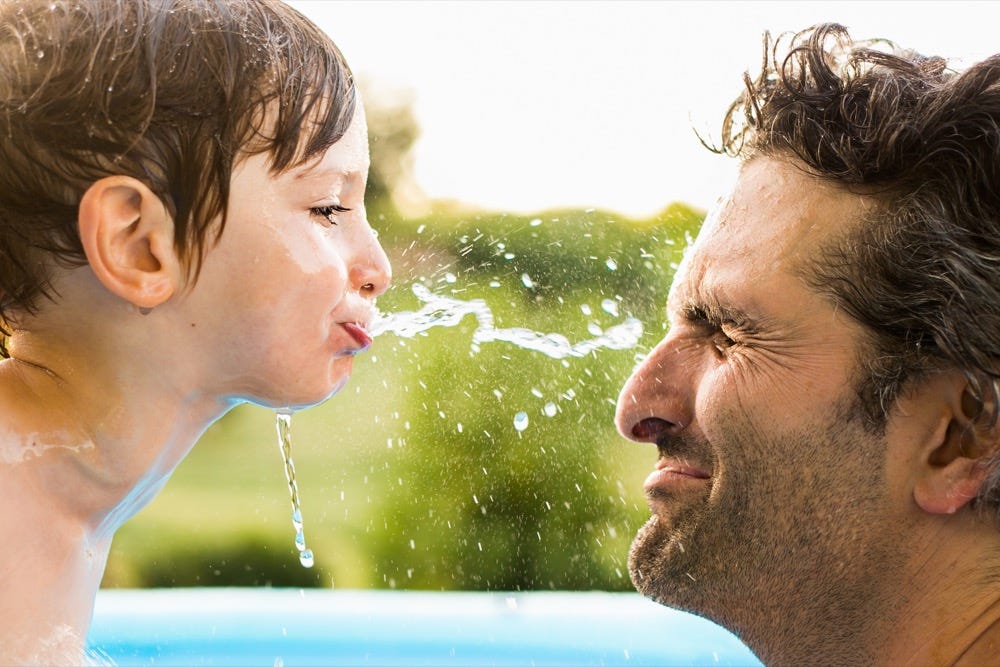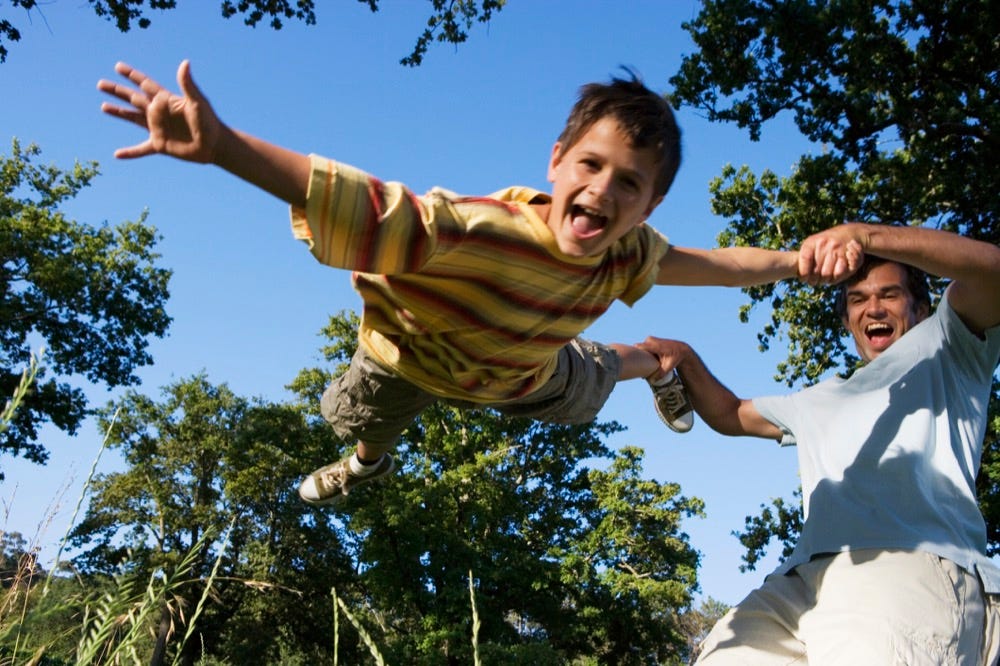I could never work out why my son used to play with a lego toy shark. All the lego figures would be nicely organised in their houses, their farmyards, their trains and their castles, the whole world running in an orderly fashion, then out of nowhere would come this violently aggressive toy shark. It would destroy everything in its path scattering entire parties at the poolside and courtiers at the castle. It tossed aside houses and horses, trains and carriages and knights and princesses, leaving a wake of chaos and destruction behind. This from my quiet, orderly, well-mannered boy. What was going on? What was going on was that he was putting into play what he could not grapple with in real life.
Play is a child’s first language. It makes sense to them – more so than words do. It’s the brain’s way of making sense of things that it couldn’t face if it were “for real”. Put a thing into play and it doesn’t count. It’s one step removed and now the “thing” is suddenly back down to size. In my son’s case that was his instinct to be “bad”.
A “good child” does not like to make a mess, does not like to make a fuss and does not tend to disrupt those around them. But destructive instincts are in each of us at our core. When things are not working out our way, and if we can’t find a safe outlet, these impulses will release themselves - sometimes violently - at the worst times and in the worst places. Play was providing my son with a safe place in which to contain his destructive instincts. A safe place in which to explore what it feels like to let it all out in the form of that terribly bad, wicked, naughty lego toy shark. The shark was the problem, not him. The shark was the “baddie” and the bane of his lego kingdom. After it had once again destroyed his lego world, he would put that shark aside and patiently tidy up the entire scene, ready for the shark’s next destructive whim.
But is that really a superpower? You might say. Can it really stop my child biting/ scratching/ wetting/ chasing after other kids all the time? Just wait: there’s more! In fact, after years of working with parents of behaviourally complex children and teens I’ve come to believe that if there is anything close to a silver bullet or a superpower to turn kids’ behaviour around, it is play. We simply need to understand it and harness its power.
Play serves emotional development
Play serves many functions, and one of them is to release emotion. To understand how play does its work, we must first understand the point of emotion. In his course The Science of Emotion[1], psychologist Gordon Neufeld talks about how the ultimate task of emotion is to “grow a child up”. Maturing and growing up is largely all about learning to manage our emotions. Studies have found that children who don’t play much have an increased chance of suffering from anxiety, attention problems and depression in childhood and emotional and social problems in adulthood.[2] It turns out that when kids are playing, emotions are doing an awful lot of work. You see emotions are nature’s answer to troubling circumstances. They are nature’s therapy as they move us from one emotional state to another.
Managing difficult behaviours
Challenging behaviour is really all about emotions making themselves heard. “Behaviour is communication” is fast becoming a catch-cry for teachers and parents alike, but what does this actually mean? Usually it means there are emotions pressing down on the child’s limbic system needing to make themselves felt. So the child instinctively lashes out. Or they curl up in a ball and won’t leave the house. Or they spit out their dinner, or refuse to hop in the car…Whatever the behaviour, it’s a small body trying to make sense of the powerful emotions coursing through them.
Stuck emotions and Troublesome behaviour
So here we have behaviour, and under it is emotion that can be explosive, challenging, confronting, and difficult to make sense of. As parents, what do we do? We most often aim to shut it down with phrases like, Stop shouting!! Don’t poke your sister! Leave that alone! Calm down! Be quiet! Stop acting like a two year old! Don’t cry - here have an ice cream.
These phrases can leave us afterwards feeling vaguely guilty though we’re not quite sure why. Aren’t we just making sure they’re behaving in a respectable manner out there in the world? Unfortunately, the things we say to try to control behaviour often leave our child feeling hurt, wounded and sometimes lashing out even further (well maybe not the part about the ice cream).
You see if emotion is there to drive us from one state to another, and we as parents are shutting down that emotion, all the work of the limbic system gets shut down too, and the child is left in a state of unresolved frustration or “stuck-ness”.
Managing Emotion
Managing tricky childhood behaviours is - at its core - about managing their emotions. How do we do that? By providing safe spaces and places for emotion to be released “on purpose” so that it doesn’t escape by accident as attack or in other ways. In my son’s case with the toy shark, the space to play uninterrupted (and me squelching my impulse to teach the shark a lesson in good manners), allowed the emotion to release all by itself.
But we can’t always rely on emotion finding its way out by itself. If there’s been lots of taboo around a child expressing emotion (eg parents who are strict with rules or trying to keep a child calm) the child’s brain may sacrifice emotional expression for the sake of the relationship and stifle feelings in order to keep a parent’s approval. This can lead to overly good children who never show warm emotions or spontaneous laughter and leave us wondering what on earth to do now. How else to manage them? Could there be a different way through all this confronting and confusing childhood behaviour?
Yes there could, and that different way through is play: this powerful, untapped, healing force that drives instinctively through each and every one of us. It’s a solution free of scolding, free of shame, free of charge and even free of work. In fact, far from being hard work – it’s fun!
The Language of Play
As adults, we often turn to therapists and therapies that allow us to release our emotions by talking them through. For children, this is not a natural way of releasing their feelings. They lack the language or the cognitive understanding to express their emotion in words and they also lack the inclination to speak to adults they are not attached to. Play, however, is fully functional in children from a very young age and courses through them, simply bursting to find its way out.
Using Play to Release Emotion
To release emotion safely in children we need to enable play. For many kids, if we simply keep the the busy-ness and booked activities at bay, and the devices out of sight, play will emerge all on its own and take care of whichever emotion most needs to be expressed. But for some kids, play goes to ground and we must intentionally invite out the emotion on purpose through playful moments and togetherness.
By using play at those times and places where you can see your little one brewing up a storm or holding in their emotions too tight, you can help release out that energy before it escalates. This allows their nervous system to release and then return to a place of rest without scolding, punishing, rewarding them or enduring another tantrum. Genius! Creating playful release of pent-up emotion is quite simply the unrecognised superpower we have as parents.
Which emotions?
What actually are these emotions that need releasing? Dr Neufeld talks of three primary emotional drives that arise when the limbic system senses threat to its safety. These are alarm, pursuit and frustration. These three are the drivers of most troubling or confronting behaviour we have to deal with as parents. If we can just get in first to help playfully release these emotions before they erupt, we can curb many of the confronting behaviours that we struggle to manage in our kids.
Best not to let them know what you’re up to though, and why. If a child works out you have a desired outcome you’re attempting to achieve through play, they will sense this on some level and caution rather than playfulness may be the energy that turns up instead.
So how do we help release alarm, pursuit and frustration? Well fortunately play has been taking care of this for millennia without our intervention. All we have to do is recognise what play is doing and then work out how to add the right sort of play at the right time to release the emotions that haven’t yet found their release.
Releasing Alarm
Alarm (that fight/ flight limbic response) sits under most anxiety. Fortunately, releasing alarm in play is instinctive in both children and their parents. Just think of all those games where a parent (often Dad) becomes a the scary monster. Kids shriek with terror as they try to cross the living room to the other side without being caught by the “Daddy Monster”. But it’s not real terror, it’s pretend terror and it’s fun, because it’s really their beloved Daddy, not a real monster. So even while they’re screaming, they’re laughing at the same time, and all that cortisol and stress in their nervous system is actually being released rather than invoked by it. The effect produced by the end of it, is one almighty high as they emerge victorious, with the sense of having conquered all their monsters. This floods the body with feel-good endorphins leaving them feeling temporarily invulnerable.[3] This is the powerful kind of natural “therapy” play produces that is hard to match in any other context.
Releasing Pursuit
Another emotion or impulse that gets stuck in the nervous system is one of pursuit. Think: that impulse to run, hide or chase. Pursuit is usually triggered by a sense of threat or separation to a child’s closest attachments, and it’s important to get it out safely. Fortunately, chasing games are as old as the hills and there’s no doubt that each one of us grew up playing some version of Tag, Hide and Seek, Sardines, Go home - stay home, Manhunt, Stuck in the Mud, Duck-Duck Goose-Goose and so on. These are great games to introduce to your kids in a Family Games Night or any other time, and each one will help playfully release pursuit energy stuck in their nervous system.
Releasing Frustration
Frustration builds in each of us when things don’t go how we want them to. Kids’ lives are full of frustration due to things they cannot change from not being allowed to eat cookies before dinner, to not being able to choose whether they stay at Mum or Dad’s house this week. Once again, play comes to the rescue. Ever wonder why play fighting ramps up between your kids at various times? When it's between siblings it can turn nasty, however, and may need some intervention. Better to playfight with an adult who knows how to not let it hurt, and when to pull back to ensure it doesn’t shift from play mode to frustration that is “for real”.
As well as play fighting, there is plenty of creative scope here for playful release of frustration. Ranging the house or the nearby playground with water pistols, or nerf guns is a favourite of many. Smacking one another with pillows or pool noodles is another (a few rules such as no hitting on head the always helps). Playing out being an aggressive character in a book or movie helps release frustration “one step removed”, or for those children less inclined to physically let loose, play fighting with toys offers an alternative way to release their frustration.
This just scratches the surface of the enormous repertoire of games and activities that can playfully release emotion. What’s more important than knowing them all, is finding your insight into the vital emotional work play is doing in all those antics that before seemed all time-wasting and silliness. The challenge is to open our eyes to the power of play, and - once we get the hang of it - to use this superpower for good, encouraging and allowing room for play in our homes and in all aspects of our children’s lives.
[1] The Science of Emotion (Vancouver: Mediamax Interactive Productions, 2015).
[2] Deborah MacNamara, Rest, Play, Grow (Aona Management Incorporated, 2016).
[3] ‘Should We Scare Our Kids This Halloween?’, Good Housekeeping, 8 October 2022, https://www.goodhousekeeping.com/life/parenting/a41557181/is-it-okay-to-scare-kids/.






